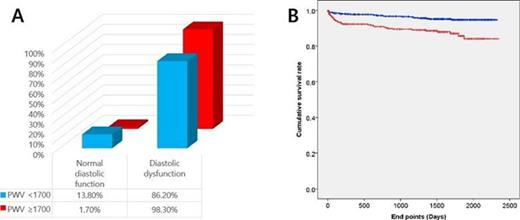-
PDF
- Split View
-
Views
-
Cite
Cite
K Kim, M.G Kang, J.S Koh, J.R Park, S.J Hwang, J.Y Hwang, H.W Park, Impact of arterial stiffness on diastolic function and outcomes of heart failure in patients presenting with acute myocardial infarction, European Heart Journal, Volume 41, Issue Supplement_2, November 2020, ehaa946.0900, https://doi.org/10.1093/ehjci/ehaa946.0900
Close - Share Icon Share
Abstract
Relation of arterial stiffness and cardiovascular disease is well-known. However, there is no data on association between diastolic function and brachial-ankle pulse wave velocity (baPWV) and influence on heart failure outcomes in patients with acute myocardial infarction (AMI).
Among patients presenting with AMI, all subjects underwent baPWV and echocardiography were recruited. Diastolic function was categorized by 2016 guideline of ASE/EACVI left ventricular diastolic function. Heart failure outcomes were defined 1) hospitalization for heart failure, 2) cardiac death and 3) sudden cardiac arrest.
Totally 1,016 subjects were enrolled (FU duration; 3.5±2.0 years, mean age 65±13, predominant male 71.3% and STEMI 40.8%) from 2012 to 2015 in the our University Hospital. Elderly, female, low BMI, higher PWV, HTN, DM and stroke were associated with higher baPWV. Increased arterial stiffness (defined as baPWV ≥1700) had higher prevalence of diastolic dysfunction compared with baPWV <1700 (98.3% vs 86.2%). HF outcomes of 69 events were identified (HF; n=48, cardiac death; n=16, sudden cardiac arrest; n=2, death d/t HF; n=3). In the multivariate analysis, baPWV ≥1700, HTN and low BMI (23 kg/m2) were independent predictors for HF outcomes after adjustment with age, LVEF, DM and stroke (Table 1). Furthermore, KM curve showed that increased arterial stiffness was associated with higher prevalence of diastolic dysfunction and poor outcomes of heart failure (Figure 1).
In patients with AMI, arterial stiffness was associated with higher prevalence of diastolic dysfunction an independent predictor for heart failure hospitalization and cardiac death.
The Impact of baPWV in AMI on HF Outcome
| Arterial stiffness and heart failure outcomes in the multivariate analysis . | |||
|---|---|---|---|
| . | B . | EXP(B) . | P-value . |
| Age >53 years old | 0.058 | ||
| Male | 0.188 | ||
| BMI <24 kg/m2 | 0.851 | 2.341 | 0.007 |
| Hypertension | 0.644 | 1.905 | 0.020 |
| Diabetes | 0.443 | ||
| Prior stroke | 0.454 | ||
| LVEF ≤50% | 1.198 | 3.314 | 0.000 |
| PWV-avg ≥1700 ms | 0.624 | 1.867 | 1.867 |
| Arterial stiffness and heart failure outcomes in the multivariate analysis . | |||
|---|---|---|---|
| . | B . | EXP(B) . | P-value . |
| Age >53 years old | 0.058 | ||
| Male | 0.188 | ||
| BMI <24 kg/m2 | 0.851 | 2.341 | 0.007 |
| Hypertension | 0.644 | 1.905 | 0.020 |
| Diabetes | 0.443 | ||
| Prior stroke | 0.454 | ||
| LVEF ≤50% | 1.198 | 3.314 | 0.000 |
| PWV-avg ≥1700 ms | 0.624 | 1.867 | 1.867 |
PWV ≥1700 was an independent factor to predict HF outcomes after adjustment with the other significant factors.

Figure 1. Diastolic dysfunction and HF in AMI
Type of funding source: None



